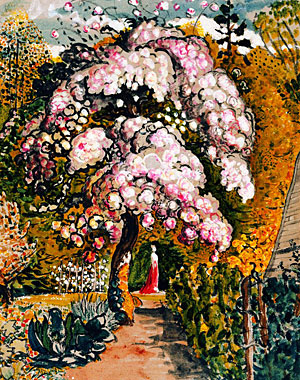It is difficult to believe that Samuel Palmer’s In a Shoreham Garden was created as long ago as 1829. Exploding with colour, light and life, this incendiary work of art – painted, in watercolour heightened with gouache, on a few square inches of cheap Bristol board – amounts to a small miracle of encapsulated feeling. Palmer’s ostensible subject is a fruit tree in blossom in a Kentish walled garden, but his real theme is the fizzing germinal energy of spring itself: the reawakening of the world, the rising of the sap. Palmer’s tree is so laden with flowers, blooms as thick as snowdrifts, that it seems to pulse and swell and flare into the atmosphere. Nearby a contemplative maid, robed in red, strolls along the garden path, her pale face tilted towards the vernal sun. Eroticism is palpably in the air but so too is a sense of religious mystery. Brightly coloured indeterminate forms halo the world with gold and green. When he was young, Palmer said that he felt as though blessed with the powers of spiritual vision. He was a friend and admirer of William Blake, whom he regarded both as a father figure and a kind of secular prophet, christening him “The Interpreter”, a name borrowed from Bunyan’s Pilgrim’s Progress. For his part, Palmer was the Moses of Shoreham. The fruit tree in the garden was his burning bush, ablaze in a grove of mystical vegetation.
Many of Palmer’s early pictures remained unknown, to all but a handful of his disciples and devotees, until well after his death in 1881. After promising beginnings, he had subsided into the career of a cautious and rather conventional Victorian painter of views, churning out pictures of Naples or the Roman Campagna as over-decorated as wedding cakes. It was as...

Samuel Palmer at The British Museum 2005
13-11-2005

